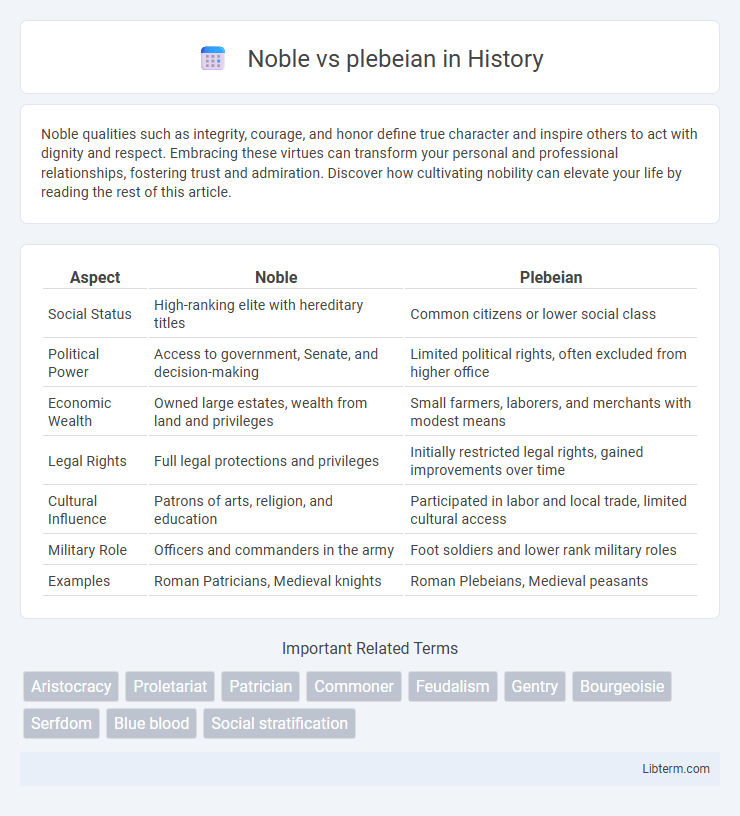Noble qualities such as integrity, courage, and honor define true character and inspire others to act with dignity and respect. Embracing these virtues can transform your personal and professional relationships, fostering trust and admiration. Discover how cultivating nobility can elevate your life by reading the rest of this article.
Table of Comparison
| Aspect | Noble | Plebeian |
|---|---|---|
| Social Status | High-ranking elite with hereditary titles | Common citizens or lower social class |
| Political Power | Access to government, Senate, and decision-making | Limited political rights, often excluded from higher office |
| Economic Wealth | Owned large estates, wealth from land and privileges | Small farmers, laborers, and merchants with modest means |
| Legal Rights | Full legal protections and privileges | Initially restricted legal rights, gained improvements over time |
| Cultural Influence | Patrons of arts, religion, and education | Participated in labor and local trade, limited cultural access |
| Military Role | Officers and commanders in the army | Foot soldiers and lower rank military roles |
| Examples | Roman Patricians, Medieval knights | Roman Plebeians, Medieval peasants |
Understanding the Noble and Plebeian Divide
The noble and plebeian divide in ancient Rome centers on social hierarchy and political power, where nobles (patricians) held hereditary privileges and controlled key religious and political offices while plebeians comprised the majority with limited rights and social mobility. Conflict between these classes led to the Conflict of the Orders, resulting in gradual plebeian access to political representation through institutions like the Tribune of the Plebs and the plebeian assembly (Concilium Plebis). Understanding this divide reveals the foundational struggle for equal rights and legal reforms shaping Roman constitutional development.
Historical Origins of Nobility and Plebeian Status
Nobility originated in ancient societies as a hereditary class possessing political power, land ownership, and social privileges, often granted by monarchs or arising from military leadership. Plebeian status emerged in early Roman society, representing common citizens who lacked aristocratic lineage, political influence, and exclusive rights enjoyed by the nobility. The historical division between nobles and plebeians shaped social hierarchies through legal distinctions, access to resources, and roles within governance structures across various civilizations.
Social Hierarchies: Nobles vs Plebeians
Noble and plebeian classes defined the rigid social hierarchies of ancient Rome, with nobles holding political power, wealth, and land ownership, while plebeians comprised the majority of the population with limited rights and economic opportunities. Nobles dominated the Senate and magistracies, influencing legislation and judicial decisions, whereas plebeians sought reforms through assemblies like the Concilium Plebis to gain legal protections and political representation. This division shaped Roman society by reinforcing class distinctions, controlling resource distribution, and driving social conflicts like the Conflict of the Orders.
Roles and Responsibilities in Society
Nobles held governing positions, overseeing land management, military leadership, and judicial duties, ensuring the stability and defense of their realms. Plebeians primarily engaged in agriculture, craftsmanship, and trade, forming the economic backbone and providing essential goods and services. The distinct roles created a structured society where power and privilege were concentrated among nobles, while plebeians contributed through productive labor and civic participation.
Economic Power: Wealth Distribution Among Classes
Noble classes historically controlled vast landholdings and accumulated wealth through feudal dues, monopolizing economic resources and trade privileges. In contrast, plebeians often faced limited access to property and financial capital, resulting in economic dependence on wages or small-scale artisan work. This stark wealth distribution reinforced social hierarchies and restricted plebeian upward mobility within feudal and early capitalist societies.
Political Influence: Governance and Representation
Nobles historically held significant political influence by occupying key governance roles and controlling legislative assemblies, which ensured their interests were prioritized in decision-making processes. Plebeians, representing the broader population, gradually gained political representation through reforms such as the creation of the Tribune of the Plebs, enabling them to veto unjust laws and advocate for social rights. This evolving power dynamic reshaped governance structures by integrating plebeian voices into political institutions previously dominated by the aristocracy.
Daily Life Comparison: Nobles vs Plebeians
Noble daily life featured spacious villas, access to luxury goods, and participation in political assemblies, while plebeians lived in crowded insulae with limited resources and focused on manual labor or trades. Nobles dined on exotic foods and wore fine clothing, contrasting with plebeians' simpler meals and modest attire. Social activities for nobles included patronage and attending theatrical performances, whereas plebeians engaged in community markets and local festivals.
Education and Cultural Access: Class Differences
Noble families historically possessed exclusive access to elite education, private tutors, and classical curricula that emphasized literature, philosophy, and the arts, which reinforced their social status. Plebeians often faced limited educational opportunities, relying on informal or community-based instruction that focused on practical skills rather than cultural refinement. These disparities in education and cultural exposure perpetuated social stratification, limiting upward mobility and reinforcing class distinctions.
Interactions and Conflicts Between Classes
Interactions between noble and plebeian classes in ancient Rome were marked by persistent social tensions and political struggles. Nobles, or patricians, held exclusive control over religious and political offices, while plebeians sought legal reforms through mechanisms like the Conflict of the Orders, leading to the creation of the Tribune of the Plebs. These conflicts culminated in significant legislation, including the Twelve Tables and the Lex Hortensia, which gradually balanced the power dynamic but maintained a clear social hierarchy.
Legacy and Modern Perspectives on Noble and Plebeian Distinctions
Noble and plebeian distinctions historically shaped social hierarchies, influencing access to power, wealth, and privileges that determined legacy and inheritance rights. Modern perspectives critique these divisions for perpetuating inequality, emphasizing meritocracy and social mobility over birthright. Current sociological discourse explores how remnants of noble-plebeian legacies impact contemporary class structures and cultural identity.
Noble Infographic

 libterm.com
libterm.com